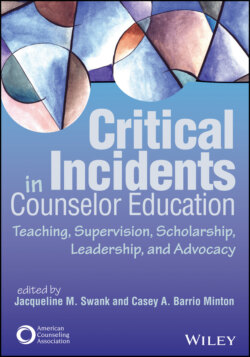Читать книгу Critical Incidents in Counselor Education - Группа авторов - Страница 27
Case Analysis and Discussion
ОглавлениеPromoting effective group work has been a long-standing challenge for many counselor educators because of the difficulty of assessing individual contributions while focusing on the overall collective assignment. Professor Madden expected students to gain knowledge of effective development of group curricula while also promoting their development as coleaders who navigate group dynamics. Given the explicit and implicit student learning outcomes of this experience, the response to this case should be viewed from multiple perspectives, namely, the ethical framework of the case, the assessment protocol implemented by Professor Madden with an emphasis on group process, and the impact on student growth and development.
Although there were no egregious ethical violations, there was a series of minor concerns that could morph into a more complex concern regarding Mary’s growth and progress through the program. None of the participants in this case study were put in harm’s way, and no one experienced significant trauma as a result of the class assignment. Yet the Preamble to the ACA Code of Ethics (American Counseling Association [ACA], 2014) specifically identifies one of the guiding principles of professional ethical behavior as fidelity, or “honoring commitments and keeping promises, including fulfilling one’s responsibilities of trust in professional relationships” (p. 3). Mary’s behavior during the group assignment did not fulfill her commitments to her peers. Although many graduate students are willing to help their peers, it seems as if Mary took advantage of the situation. She made unilateral decisions that impacted her peers without consulting them.
As an emerging counselor who will be expected to follow the ACA Code of Ethics (ACA, 2014), it is imperative that Mary also understand that “counselors aspire to open, honest, and accurate communication in dealing with the public and other professionals” (p. 8, Section C). During the assignment, Mary stopped actively and accurately communicating with her peers. As she continues to develop as a counselor, she will need to cultivate and demonstrate that critical area of ethical comportment.
The role of the instructor is another important consideration. Specifically, Professor Madden could have put measures in place to better support and protect the interest of all students. This includes recognizing dynamics of group projects in which the distribution of work is ultimately inequitable. As in other areas of professional life, an equitable distribution of work may not be realistic, yet it is important to consider. Professor Madden might have provided information to enhance the learning environment and better support students by clearly stating expectations and providing “ongoing feedback regarding their performance throughout the training program” (ACA, 2014, Standard F.9.a.) Similarly, CACREP Standards emphasize the critical role of assessing student learning and dispositions throughout the program (CACREP, 2016, Section 4, Standards F and G). Professor Madden could have integrated specific assessment protocols and feedback processes to mitigate some of the challenges of inequitable work distribution.
Professor Madden comes across as having developed an assignment, assigned students to work groups, and provided direction and expectations with attention to a final due date. What is missing are the steps he could have taken to ensure that all students had a fair opportunity for success as group members and as individuals. There could have been one or two benchmark opportunities for group members to receive instructor support for their work. In addition, groups could have clearly delineated individual tasks or responsibilities in writing with Professor Madden.
The group counseling course and the corresponding project are ideal for the development and implementation of a rubric or set of rubrics that clearly articulate goals and expectations of the project. Assessment rubrics should also clearly articulate how each student will be evaluated. Learning outcomes are important to graduate education and counselor training, as the role of a professional counselor is action oriented. With this being said, it is important to have a defined set of outcome measures within each course. Students need to know whether they are being assessed on the group process or the group product. The rubric in Table 2.1 provides an example of how to assess group performance.
The students could have been better supported in their experience if Professor Madden had developed a few benchmarks for the assignment. For example, the students could have turned in work plans that outlined the type of project they intended to complete, the timeline for completion, and the distribution of tasks among group members. This could have supported the students’ efforts and also allowed Professor Madden an opportunity to lend support and have a working knowledge of what each group intended to accomplish. Professor Madden could have developed a rubric to outline what aspects of the final assignment needed to be present in the benchmark. The rubric also could have delineated whether any assessments were individual rather than group based. This would have assisted each student in a self-assessment of their work and helped them begin to answer the overall question of whether they had done their part.
